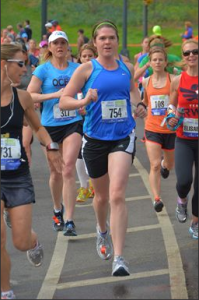Today we’re going to de-mystify running for fat loss.
As New Years Day passed by, I couldn’t help but notice one thing in Sydney (apart from my headache and the skinny fat chicks). You probably witnessed this too.
All of a sudden, the local running paths, treadmills and beaches were filled with all kinds of people slogging it out, trying to lose belly fat.

view from a Sydney run
Hello resolution runners.
You know who I’m talking about. These folks let their health goals slip away over the year. The added stress of work and poor time management resulted in a long hiatus from training, and the gradual gain of belly fat. So over a couple of beers on New Years Eve, these former weekend warriors decided to kick-start 2013 by losing a solid ten pounds.
Come New Year’s morning, they dusted off their sneakers, tied up their laces, and hit the road for a good ol’ run.
Great intentions.
Big mistake.
Five years ago, I was on this bandwagon. I was a notorious resolution runner. A scorching hot New Year’s day, I woke up with a terrible hangover and decided this would be the year I lost those annoying ten pounds of stubborn belly fat – and I was convinced running was the fastest way to success.
Sure enough, I started out with the intention to run for slow 30 minutes, despite the intense heat. I cursed every minute as I stared at my watch in disbelief, as I couldn’t even manage a slow, painful 15 minutes without stopping. Not to mention my knees and hips were killing me. Massive fail.
3 Problems with Running for Fat Loss
“Run and you will lose weight fast.” You’ve heard it all before. But is this the magic move that will accelerate your fat loss?
Unlikely.
Sure, running is a useful way to shed the unwanted pounds, but it’s not a quick fix solution, and certainly not an exercise I recommend for overweight, untrained folks who want to lose belly fat.
Why?
1. You will get injured eventually
The number one mistake resolution runners make is the omission of strength training from their fat loss program. I’ve heard it all before. “I don’t need to train my legs, that’s why I run.” Bad idea. Terrible, in fact.
Running a few miles at a slow pace may sound trouble-free, but it’s beating up your body more than you think.
One mile of running requires you to do 1,500 reps of one-legged plyometric (jumping) exercise. Plus, running produces forces in the range of 2-5 times your body weight per foot contact. Pretty intense stuff for your first workout back after a long layoff, don’t you think?
You are setting yourself up for injury. In fact, you’re more than 65% likely to suffer an overuse injury when you’re out of shape and take up running, even if you ran track in college ten years ago. Sitting on the sideline injured does not burn many calories.
Clearly, taking up running is NOT the most effective exercise to burn belly fat.
2. Form and technique
Running is not as easy as it looks in the Olympics. Just because it’s cheap and accessible, doesn’t mean it’s right for you. Like anything, perfecting your run style takes time and practice… Consistency is key here.
Most folks fail to get advice on how to run correctly, until injury strikes and its too late. Running is an art form, a human mechanical one at that. Optimal technique will improve your efficiency and reduce your risk of injury.
3. The post run pig out session
You go running and come back with a mean appetite. During your run, all you could think about was the delicious stuff you could devour afterwards. And not feel guilty about it.
Do you “run to eat”?
Chips, beer, banana bread, pasta.
Well, you know that run workout was a TOTAL waste of time and energy? Burning a big number of calories does not give you a free pass to go wild at the dinner table. You will actually gain fat… It’s tricky, because a high volume of aerobic exercise makes you hungry, however the calorie expenditure is not as high as you think.
Calculated calorie expenditure while running is often overestimated, especially on the dreadmill. Use those numbers as a benchmark on your run, but don’t count on consuming that number of calories post run.

that’s me racing celebrities
Pass on the chips and re-fuel with quality, unprocessed foods that promote fat burning.
You know I love to run so you might be thinking, “Hey Kate, you go running all the time. What on earth are you talking about?!”
Well folks, my goal right now is NOT to lose belly fat. If it were, I’d be following this hierarchy below. I’m training to get strong and fast to qualify for the Boston marathon, and then I have my eyes on the gold medal at the 2016 Olympics in Rio. ![]()
Fast Fat Loss Plan
It took MANY years for me to accept “I’ll just go for a run” was NOT the most effective training method for losing fat. Even though I was going for a fast run, I was not consistently strength training and my nutrition plan resembled the see-food diet (you just eat whatever food you see). Ah, the college days. This caused a few injuries, and boy I wasted plenty of time.
You want to lose fat fast, right? My advice is straightforward. First, don’t make the same mistakes I did. Instead follow the Fat Loss Hierarchy. It’s simple, but not easy. The following is listed in order of importance:
[features_box_blue width="75%" + border="2px"]
Fat Loss Hierarchy
1. Correct fat loss nutrition
2. See number one. Make sure you get it right – it’s really that important
3. Total body strength training program
4. Metabolic resistance training / High intensity intervals
5. Steady state exercise (like running)[/features_box_blue]
The most effective, proven method to lose stubborn belly fat is with a combination of sections 1-4 in this hierarchy. Focus your energy here. Seriously, you must get your nutrition down. You’ll save yourself the heartbreak of training hard and not seeing results.
Don’t take this post as a bash against running. This sport is one close to my heart and an exercise I now find enjoyable because my body is strong and 40+ pounds lighter.
Final Word on Running for Fat Loss
Only consider including running in your program once you have shed the unwanted pounds. Not only will your running be more efficient, you will be faster, stronger and less likely to be sidelined by injury.
Accepting responsibility for your actions is the first step to getting results. Secondly, you need to change and try something new if what you’re doing is not working.
Be smart. Get strong and back in shape before you run, and save yourself time on the injured list.
Have an awesome week,
KV
















One Reply